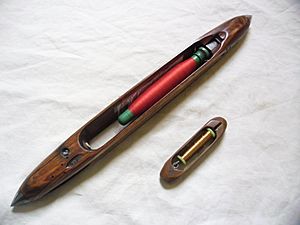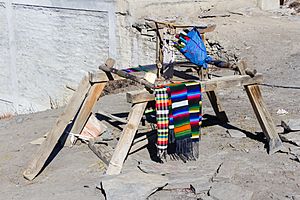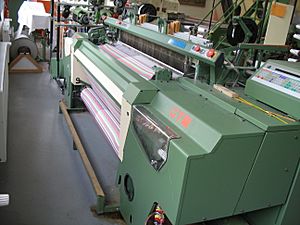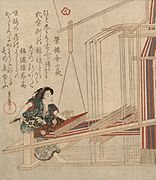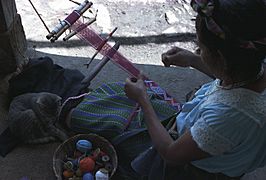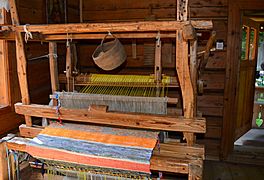Loom facts for kids
A loom is a special machine or device used to make cloth. It works by holding long threads, called warp threads, tightly stretched. Then, it weaves other threads, called weft threads, through them. No matter what a loom looks like, its main job is always the same: to keep the warp threads tense so the weft threads can be woven in easily.
The word "loom" comes from an old English word, "geloma," which meant any kind of tool or machine. By the 1400s, it specifically meant a machine for weaving thread into cloth.
Contents
How Weaving Works
Weaving is the process of crossing two sets of threads over and under each other. The threads that run lengthwise (up and down) are called the warp. The threads that go across (side to side) are called the weft.
A loom has several main parts:
- The warp beam holds all the warp threads.
- Heddles are wires that hold individual warp threads.
- Harnesses are frames that hold the heddles.
- The shuttle carries the weft thread.
- The reed looks like a comb and pushes the weft thread into place.
- The takeup roll winds up the finished cloth.
Weaving involves three main steps:
Shedding
Shedding is when some of the warp threads are lifted up to create a space called a shed. This space is where the weft thread will pass through. On modern looms, this lifting is done automatically by the heddles and harnesses. The pattern of the cloth decides which threads are lifted.
Picking
Once the shed is open, the weft thread is inserted through it. This is usually done by a small device called a shuttle. The shuttle is pointed at both ends to help it move smoothly. Inside the shuttle, the weft thread is wound onto a small spool. As the shuttle moves across the loom, the thread comes out through a hole. One trip of the shuttle across the loom is called a "pick." As the shuttle goes back and forth, it creates a neat edge on both sides of the fabric, called a selvage, which stops the fabric from falling apart.
Battening
After the shuttle has laid down the weft thread, the weaver uses the reed (the comb-like part) to push the new weft thread tightly against the fabric that has already been woven. This part of the fabric is called the fell. This step makes the cloth strong and even. Older looms could do about 150 to 160 picks per minute.
After each weaving step, the newly made fabric is wound onto a cloth beam. At the same time, new warp threads are released from the warp beam. Some looms also have a safety feature called a "filling stop motion." This stops the loom if the weft thread breaks.
Types of Looms
Backstrap Loom
A backstrap loom is a very old and simple type of loom. It uses two sticks or bars to hold the warp threads. One bar is tied to something fixed, like a tree or post. The other bar is attached to the weaver, usually with a strap around their back. The weaver uses their body weight to keep the threads tight.
Weavers can make both simple and complex fabrics on these looms. The width of the fabric is limited by how far the weaver can reach. Many cultures around the world still use backstrap looms today to make things like belts, bags, and ponchos.
Warp-Weighted Loom
The warp-weighted loom is a vertical loom that might have been invented thousands of years ago. It was used in ancient Greece and then spread across Europe. Its special feature is that it uses weights hanging from the warp threads to keep them tight. When the weaver reaches the bottom of the threads, they can roll up the finished part and unroll more warp threads from the weights to keep weaving. This means they can make very long pieces of cloth.
Drawloom
A drawloom is a hand-powered loom used to weave cloth with complex patterns, like flowers or animals. On a drawloom, each warp thread can be controlled separately. This loom needed two people to operate: the weaver and an assistant called a "drawboy" who would manage the pattern threads.
The earliest drawloom fabrics were found in China around 400 BC. Many experts believe the ancient Chinese invented this loom. It helped speed up the making of silk and was very important in Chinese silk weaving. Later, it was brought to Persia, India, and Europe.
Handloom
A handloom is a basic machine used for weaving. On a wooden handloom, the heddles are held in frames called shafts. The warp threads pass through these heddles or through spaces between them. When a shaft is lifted, it raises half the threads, while the other half stays in place. This creates the shed. This was a big step forward in weaving technology in the 13th century.
Flying Shuttle
Before the flying shuttle, weavers could only make cloth as wide as their arms could reach. If wider cloth was needed, two people had to work together. In 1733, John Kay invented the flying shuttle. This device allowed a single weaver to send the shuttle across the loom with a quick flick of a stick. This made weaving much faster and allowed for wider fabrics.
The flying shuttle was a very important invention that helped start the Industrial Revolution. It meant that the weaving process no longer relied on a person's arm strength, making it easier to power looms with machines later on.
Vertical and Horizontal Looms
Looms used for making traditional tapestries are often called haute-lisse looms. On these, the warp threads hang vertically (up and down) between two rolls. In contrast, basse-lisse looms have the warp threads stretched horizontally (side to side).
Other Traditional Looms
There are many other types of hand looms, such as the simple frame loom, pit loom, free-standing loom, and pegged loom. These looms are still used in many developing countries to create jobs and income.
Power Looms
Edmund Cartwright built and patented the first power loom in 1785. This invention was quickly adopted by the growing cotton industry in England. Early power looms were not perfect, but inventors in England kept improving them. By 1818, there were many factories using thousands of power looms.
The Roberts Loom in 1830 was a major breakthrough. Over time, more improvements were made, leading to the Lancashire Loom in 1841. This loom was semi-automatic, meaning a young person could operate six looms at once. This made power looms much cheaper to run than handlooms for simple fabrics. However, for complex patterns, handloom weavers were still needed until the 1870s.
Later, the fully automatic Northrop Loom was invented. This loom could even reload the shuttle by itself when it ran out of thread. By 1942, even faster and more efficient looms were developed that didn't even need a shuttle. Modern industrial looms can weave incredibly fast, inserting thousands of weft threads per minute.
How Weft is Inserted in Modern Looms
Modern looms are often named by how they insert the weft thread. Many new ways have been developed to make cloth cheaper to produce. Here are the main types:
- Shuttle Looms: These were the first power looms. They use a shuttle with a spool of weft thread inside, similar to traditional handlooms. These looms are now considered old-fashioned in factories because they are slow, only making about 300 picks per minute.
- Air Jet Looms: These looms use short, strong blasts of compressed air to shoot the weft thread through the shed. Air jet looms are the fastest type of traditional weaving machine today, able to make up to 1,500 picks per minute. However, they need a lot of compressed air, which can be expensive.
- Water Jet Looms: Similar to air jet looms, but they use powerful jets of water to propel the weft. These can be cheaper to run if water is easily available. They can reach speeds of up to 1,000 picks per minute.
- Rapier Looms: These looms are very flexible and can weave with many different types of threads. They use a hook system, often attached to a rod or metal band, to pull the weft thread across the shed. They usually make about 700 picks per minute.
- Projectile Looms: These looms use a small object, like a bullet, that is shot across the shed, usually by a spring. This object carries the weft thread. After it crosses, it returns to the other side to be reused. Multiple projectiles are often used to speed up the process. These machines can reach speeds of up to 1,050 picks per minute.
Making Patterns: Dobby and Jacquard Looms
Dobby Looms
A dobby loom is a type of floor loom that can control each warp thread using a special "dobby head." The word "dobby" comes from "draw boy," which was the name for the helpers who used to pull threads to create patterns. Dobby looms are an improvement over older looms where only a few harnesses could be controlled by foot pedals.
Jacquard Looms
The Jacquard loom was invented by Joseph Marie Jacquard in 1801. It made it much easier to create complex patterns in fabrics like brocade and damask. This loom uses punched cards, where holes in the cards tell the loom which warp threads to lift for each row of the design. Many cards are linked together to create the full pattern.
The Jacquard loom was a very important invention. It was even a step towards the punch card computers that came much later. The "Jacquard head" could be added to both power looms and handlooms, allowing them to weave very detailed designs.
Circular Looms
A circular loom makes a seamless tube of fabric. This is used for things like socks, bags, clothing, and fire hoses. Small circular looms can be used for Circular knitting, while large ones are used for modern clothes. Modern circular looms can use many shuttles that move in a circle, driven by magnets. The warp threads rise and fall as each shuttle passes, creating a continuous tube of cloth.
Symbolism and Cultural Significance
The loom is often seen as a symbol of creation and how our lives are woven together. In ancient Greek myths, the goddess Athene turned Arachne into a spider because she was jealous of Arachne's amazing weaving skills. In Maya cultures, the moon goddess Ixchel is said to have taught the first woman how to weave at the beginning of time.
Gallery
-
Model of Navajo Loom, late 19th century, Brooklyn Museum.
-
An early 19th-century Japanese loom with several heddles, controlled by the weaver's foot.
-
Hand loom at Hjerl Hede, Denmark, showing warp threads and woven cloth.
Images for kids
-
A loom in an Old Believer homestead in Slutiški, Latvia.
See also
 In Spanish: Telar para niños
In Spanish: Telar para niños


